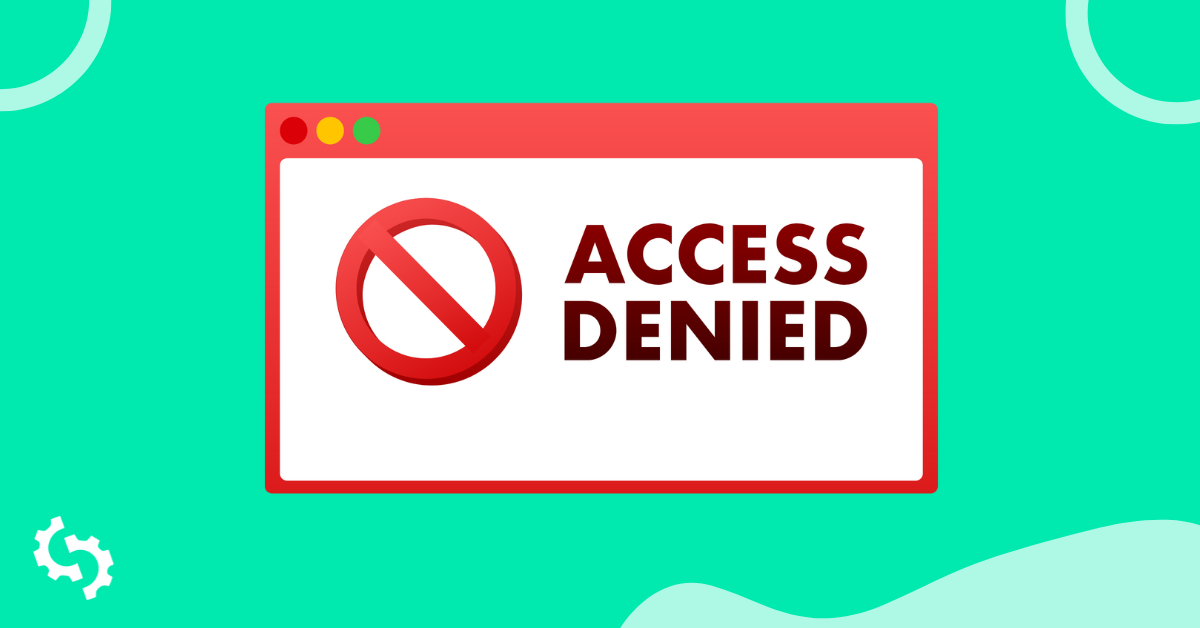
It's enough that link building is hard.
Don't make it any harder by ignoring resource page link building opportunities.
They're practically begging you to take them.
You might even think that they're too easy. Too good to be true.
They're probably not worth having in your backlink profile if they're that easy to score. But in this case, you'd be wrong.
You want to be on the most authoritative resource pages in your niche, industry or locality.
Getting backlinks from these pages to your website is one of the easiest and fastest link building strategies you can take on, and it also has a very positive impact on your SEO—if you know how to do it right.
So how do you use this tactic effectively?
Let's get the answers.
Resource page link building basics
Resource page link building is one of the top two tactics that webmasters are using to acquire backlinks to their sites.
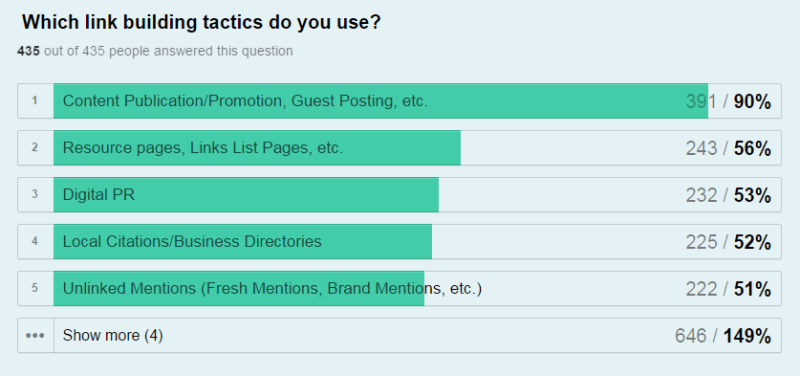
Resource pages are web pages that link to industry, educational or local resources (i.e. article, videos, audios/podcasts, infographics and even comics) that improve the user experience of site visitors. Some resource pages simply list the links, others list and give brief explanations of each resource listed.
Ultimately, you earn links from resource pages by being the best resource on your topic. Most authoritative resource pages take the pain to filter for the best resources; you want to be their preferred resource material.
Resource page link building is easy because those pages exist just to link back to other sites! You're welcome to pitch your content. Plus you can examine what's already on a resource page and develop a resource that's 10X better.
Unlike most other tactics, resource page link building gives you significant control and predictability in your link building efforts.
Here's how to get your site featured on resource pages.
#1: Be an irresistible resource
The first and most important step is to make sure you're a quality resource and worth being featured.
The objective of a resource page is to provide readers with the very best materials in the industry. And that's what you want your content to be—the best in the industry.
How do you develop compelling content?
Well, excellent content will depend on the audience you're targeting. But here's a quick checklist to help you craft your magic.
- Create a resource that contains all the juice on the topic so your visitors won't have to look anywhere else for answers.
- Use data and statistics to support your points.
- Make the content visually compelling.
- Give actionable steps, guides and walk-throughs.
- Use case studies to tell engaging stories.
- Provide your users with the resources to support action: spreadsheets, toolkits, directory listings, checklists, etc.
Infographics and visual content tend to engage people more, maybe because we retain 65% of what we see compared to 10% of what we read.
Content Marketing Institute says that 73% of content creators are favoring visual content. And that's probably because content consumers are demanding more visual content.
In fact, in 2017, video commanded as much as 74% of total internet traffic, and that figure is estimated to hit 80% by 2019.
In short, you want to use:
1. These content creation trends,
2. An understanding of your audience, and
3. The other ingredients of useful content
...to inform and direct your resource content effort.
#2: Find relevant resource pages
Your goal is to gain power-packed links from resource pages, not just another backlink. So you want to focus your resource page link building on pages that meet specific criteria:
- High Domain Authority
- High Page Authority
- Low Spam Score
To measure a page's backlink worthiness based on these three factors above, you can use a tool like the MozBar Chrome extension to check the quality metrics of the pages directly from SERPs. Google, Bing and other search engines are all good enough for finding the likely resource pages you'd be targeting in your campaign.
Use any of these search strings below to find the best resource pages to target:
- "Keyword" intitle:“helpful links”
- "Keyword" inurl:“helpful links”
- "Keyword" intitle:"useful resources"
- "Keyword" inurl:"useful resources"
- "Keyword" intitle:"resources"
- "Keyword" inurl:"resources"
- "Keyword" intitle:"links"
- "Keyword" inurl:"links"
- "Keyword" intitle:“helpful resources"
- "Keyword" inurl:“helpful resources"
- "Keyword" intitle:“useful links”
- "Keyword" inurl:“useful links”
Remember to change the "keyword" to your target keyword for the page or any keyword that's relevant to your resource page link building interests. You can also replace the "keyword" with the name of your specific industry. And you may even add other variables to your search string, like:
- Your city
- Targeted TLD (e.g. .org, .gov, .edu, .ny, .co.uk, etc)
- Negative search commands (e.g. –inurl:pdf, –inurl:ppt, –inurl:doc)
Negative search commands will weed out downloadable items—like PDF, PowerPoint and other document files—from your search results.
These are usually business, industry, academic or government reports or presentations, that may contain terms like "resources" or "links" in them. But that's usually to reference links and resources within the file—not resource pages.
So, you can use strings like:
- “city” site:.gov intitle:"helpful links" –inurl:pdf –inurl:ppt –inurl:doc
- “keyword” site:.org inurl:”resources” -inurl:pdf -inurl:ppt -inurl:doc
- “industry” site:.co.uk intitle:"helpful links" –inurl:pdf –inurl:ppt –inurl:doc
- “city” site:.edu intitle:"helpful links" –inurl:pdf –inurl:ppt –inurl:doc
- “Keyword” site:.org inurl:”resources”
- “City” site:.gov inurl:”resources”
- “Industry” site:.org inurl:”resources”
- “Keyword” site:.edu inurl:”links”
Know that the search strings above are rather strict. You might find very little or no results at all.
Let's take an example, using one of the more general search strings, with the keyword "vegan diet" like in the screenshot below.

I got these results. With the MozBar extension turned on, you can easily spot your best leads. You can see that there are some authoritative sites with good DA and PA scores.
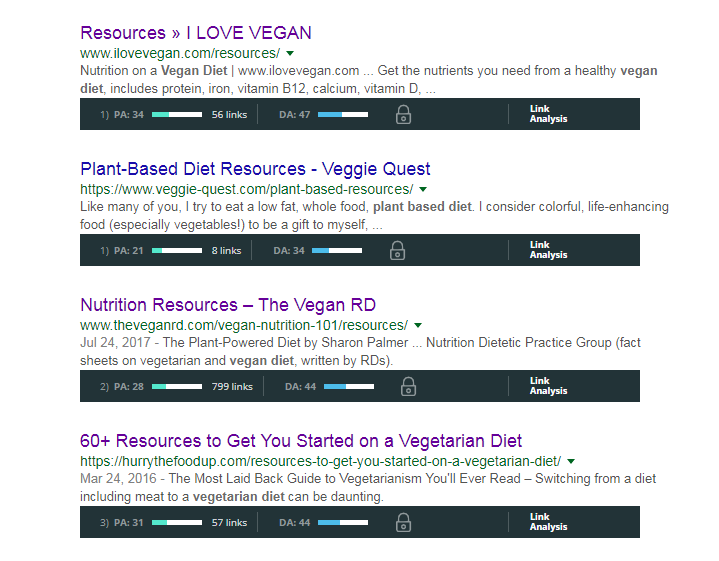
They'll give you some link juice, too. Here's a resource page with do-follow links.
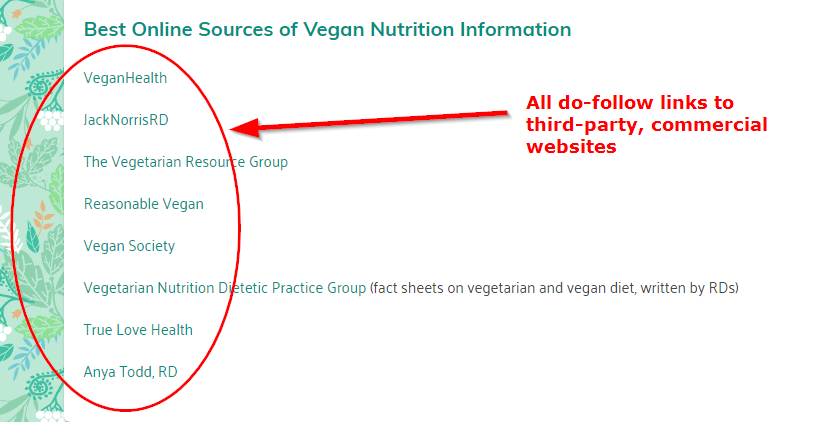
When researching, don't turn a blind eye to resource pages that aren't precisely links-only pages. Here's an example from that "vegan diet" search.

Resource pages like this one might even be better at increasing clicks to your site because they sell readers on your value and invite them to click to visit your website, as well as including a backlink.
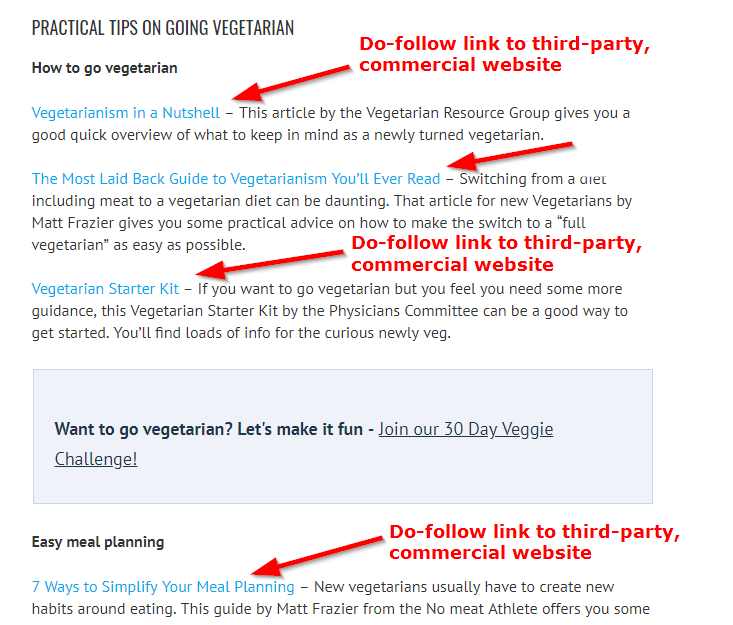
I prefer resource pages like this one because Google would be more likely to show it in searches, since it's giving more value than just links.
Resource page categories to search
You can use the search queries above across multiple, relevant categories to find all the best resource pages you can hop on. Breaking down your search into categories like this helps you exhaust the link juice in this space.
To help you on this path, I've created a free spreadsheet on Google Sheets you can copy and use.
Get your free spreadsheet template here.
This is a good way to keep an organized list of targeted resource pages to pitch in the next step.
You can make a copy for yourself. Just click on "File" and then "Make a copy," as shown in the image below.
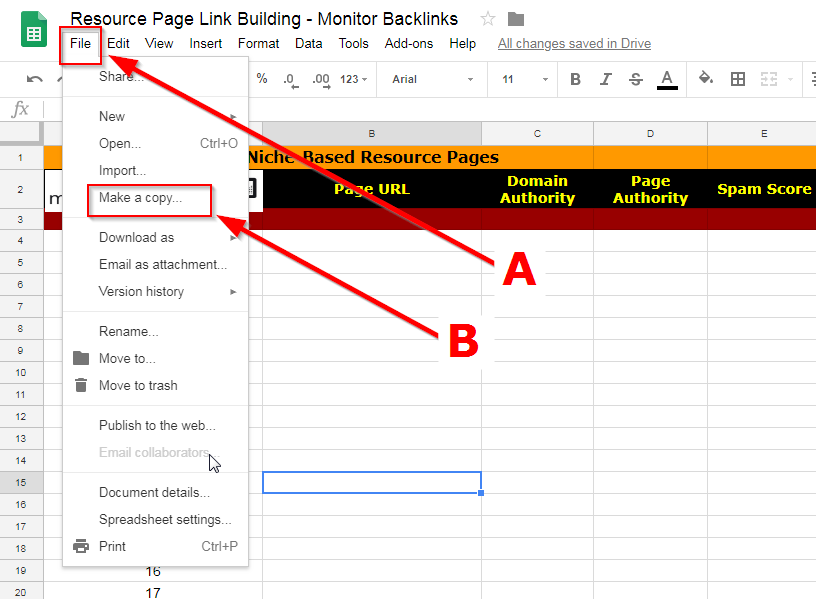
Use the tabs at the bottom of the page to access different categories of resource pages.

Location-based resource pages
To get on local resource pages, use local TLDs (depending on your city or country). Canada, .ca; Japan, .jp; South Africa, .co.za; Senegal, .sn; Ireland, .ie; and the list goes on.
You can find your city's or country's Top-Level Domain on the ICANNWiki site here.
Backlinks from local resource pages signal to search engines that your business should rank high in those countries and cities for the search term you're optimizing for.
Academic-based resource pages
This is one of my favorite resource page link building channels. Even when they're no-follow, they're still powerful.
So, a do-follow backline from an .edu site will blow your socks off!
And, oh yes—you can have do-follow backlinks from the likes of MIT. Let me show you.
It's time to use those search strings again. Let's say I searched for the keyword "vegetarian foods" using one of those strings.

This is the search engine result I got (with the MozBar turned on to help me focus on the pages with high DA and PA).
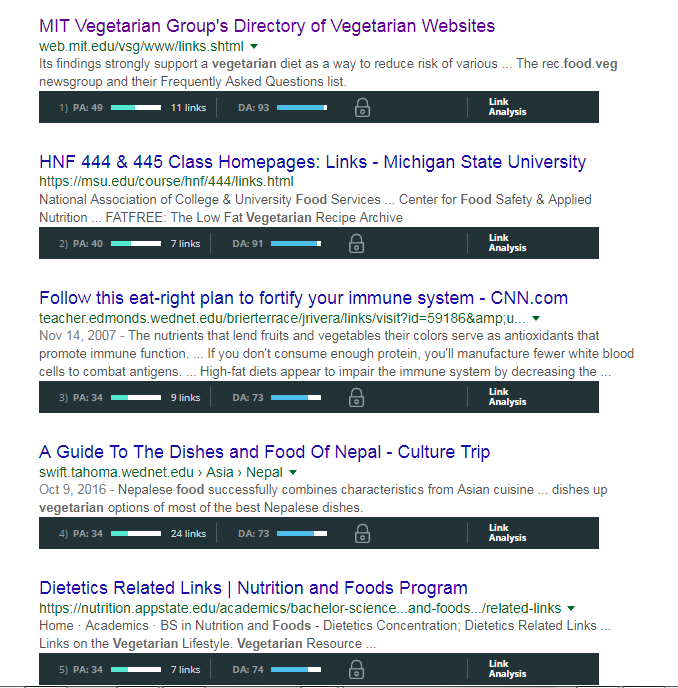
You'll notice the resource list from MIT with a DA of 93, PA of 49. The page has a Spam Score of 0/17. Pretty neat isn't it?

And then I discovered that the links are do-follow!
Wow. Mind equals blown.
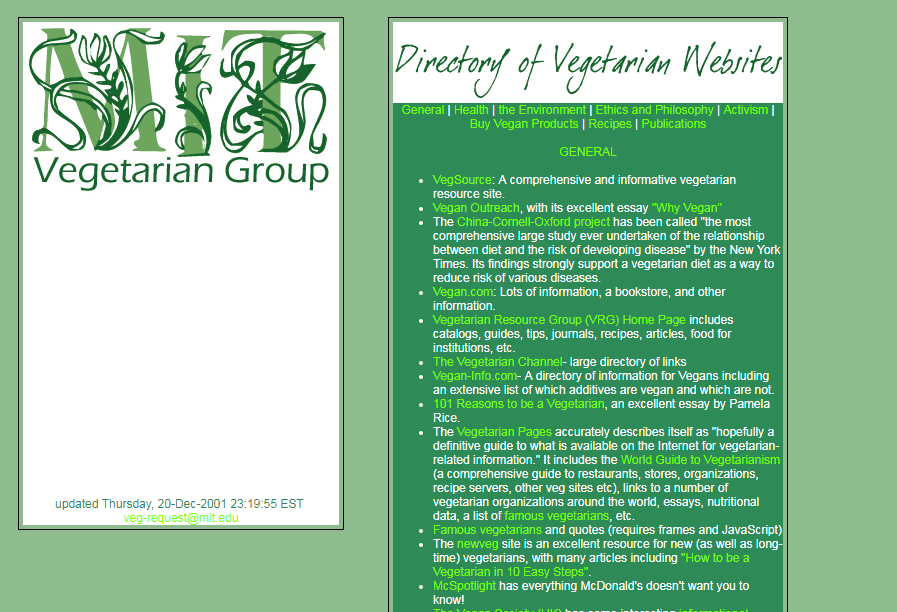
You won't be lucky enough to get opportunities like this all the time. But you'll miss out if you don't look for them.
Government resource pages
Government and university websites are the toughest places to find link opportunities—plus backlinks are usually no-follow—but they're also some of the most powerful.
Let's take an example.

Here are the results (notice the high DA scores!):
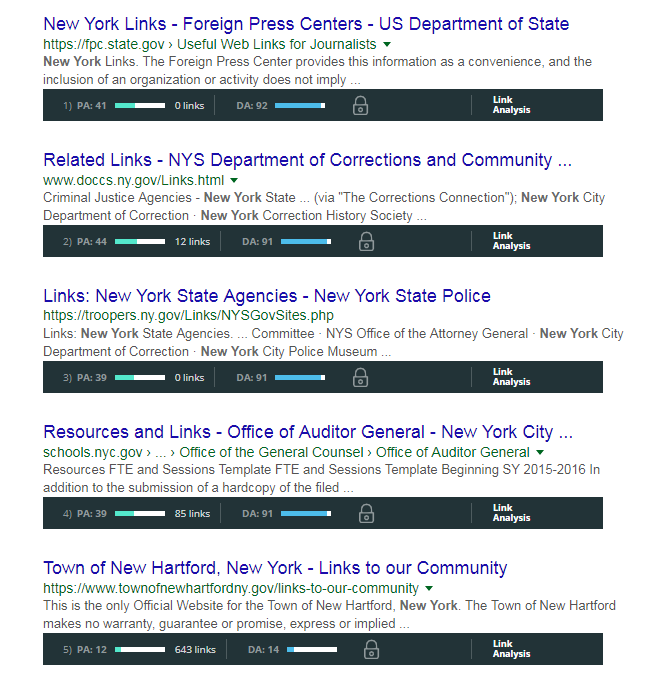
Be aware that unless your business has existing affiliations with the government, you might find it an uphill task to get on any of their resource pages. But, hey, don't use that as an excuse!
Do your research first—be thorough. If you can provide a resource that's relevant enough, you might just get yourself a backlink.
Niche-based resource pages
Most regular industry and niche-based resource pages use .com or .org TLDs. You can easily find them on Google with any of the search strings I mentioned earlier.
Complimentary niche-based resource pages
Complimentary niches are niches that support your niche or that your niche supports.
For example, "vegan diet" might be a complimentary niche to a website that focuses on "body-building and fitness."
The broken backlinks approach
This is a pretty straightforward resource page link building tactic that can be used on any resource page in any category.
The idea is to find broken backlinks on resource pages related to your niche, and then ask the resource page owner to let you provide a replacement for the bad or broken link. More often than not, the answer would be yes.
In fact, we have a robust resource to help you make the most of this resource page link building tactic.
Beware of link farms!
In your research for the best resource pages, make sure you keep away from link farms. Link farms are websites that exist for the purpose of link building only, and nothing more—and they commonly host resource pages.
Google won't give your site a hearing if it finds backlinks from these sites pointing to your resources.
Easy signs that a page is a link farm:
- High Spam Score (over 4/17)
- You can pay to get a do-follow link
- The page is full of links to low-quality resources
- Thin website content (great resource pages complement content-rich sites)
- Website admin demands a link exchange to feature your resource
Overall, you want to keep an eye on the quality of links your resources are earning. Don't get links from pages showing any of these signs.
#3: Find out who's in charge and how to reach them
Now, you should have a spreadsheet full of relevant websites to pitch about featuring your site as a resource. The next step is to find out who to talk to about getting your resource on the site.
Your goal here is to find the name of the person and their email address.
The right contact persons would likely have titles like Chief Marketing Officer (CMO), Content Coordinator, VP Marketing, Content Strategist, Social Media Strategist, and the like. In some instances, the CEO, Founder, Editor-In-Chief, Author and the like might be the right targets.
You have four options for finding the right contact persons and their email addresses.
Option #1
Search their websites to find the persons in charge of contents and their email addresses, if they're on the site. Not contact forms—find direct email addresses.
You can also use Google search. You can search "CMO of [company or website]" or "chief editor of [website]" to find appropriate target persons.
Option #2
Use company profile websites like Crunchbase or AngelList to search for who the company's execs are, and who leads the content marketing and creation for the website.
Option #3
Search their social media accounts or public profiles. Look for contact persons and email addresses on their Facebook, LinkedIn, Twitter or YouTube.
RecruitEm can help you find appropriate persons to target from a range of social media profiles.
Option #4
Use an email search tool like Anymail finder to find the emails of your target persons.
If you've gone through options 1 -3 above, you'd have found the names of your target persons for each website would. Remember to keep their contacts in your Google Sheet.
In my experience, it's best you have a list of all your target persons and websites ready before using Anymail finder. To use the email finder tool, create a .csv spreadsheet with two different columns containing:
1. The URLs of the websites you're targeting, and,
2. The full names of the contact persons.
You can use Google Sheets to create the spreadsheet and then download the data. Upload the document to Anymail finder using its bulk email feature—the tool lets you upload up to 50,000 names and websites for free.
Now, you have your email list! Put that list into your spreadsheet, ready to start reaching out.
#4: Craft a magnetic pitch and launch your campaign
This is where the magic happens!
A sound pitch gives your content the opportunity to land on coveted resource pages. Albeit, the volume of prospects on your list determines your pitching channel.
Use a regular business email service if your prospect list is small. Large lists work better with campaign management tools like Pitchbox or Mailshake.
You'd then tailor your pitch to match the website you're targeting.
Here are cold pitching ingredients to warm your way into the hearts of your targets:
- Know and call them by name (it establishes rapport and shows the message is for them)
- Introduce yourself and say what you do in a line or less
- Establish credibility for yourself or your business (aim to reflect your value. Don't brag)
- Acknowledge their work
- Mention your resource
- Close the pitch and invite a reply
Now let's put this template to work. Here's a sample pitch you can tweak to fit your needs.
Of course, you'd want to change the sentence that reads "Just something to help the academic community" if your message isn't targeting university or academic websites.Hello [Name],
I'm Nicholas from [website or company name]. I cover [niche] and have been featured on [places you've been featured, mentioned or quoted].
Earlier today, I had the opportunity to find your resource list on [URL of page]. Great material.
I had just recently created an [article/infographic/explainer video/whitepaper] on [title or topic of resource page] and was thinking it'd be a good addition to the awesome resources you have on your list.
Here's the link to the resource: [your URL]
I'll be glad to know if you found the material a fit for your list. No obligations. Just something to help the academic community.
Regards,
Nicholas
If you're targeting websites in your industry, you can change "the academic" to "our industry." And if you're targeting a local or government resource page, you can use "our community/city" instead.
If your credentials are too thin to establish strong credibility on the topic, ignore that line and head straight to other parts of your pitch. Adding your credentials increases your chances of being accepted, but won't damage all your chances if you omit it. If your resource is fascinating enough, resource page admins will pay attention.
#5: Monitor your progress
Now that you've launched your resource page link building rocket, you want to do one more thing—keep an eye on your rocket.
What's the point of throwing your energy around in cyberspace without knowing for sure what's working and what's not?
You can use SEOptimer to keep an eye on your resource page backlinks as they happen. You'll get email alerts as the links hit your site, so you know what links you've won and whether there are any you should follow up on.
It also lets you know if any of your backlinks change in quality. For example, you could have a link from a low Spam Score resource page today, and then things change in future. The site diminishes in value and gathers an unhealthy Spam Score.
Monitoring your link building progress helps you respond before any lousy links become toxic.
Conclusion
Now it's action time.
Follow these five steps, track your progress, course-correct as needed, and then get results.
Start building!



